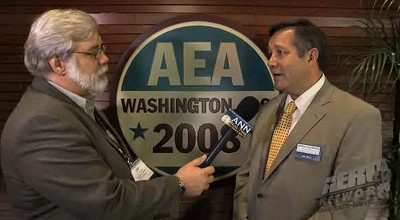Excellent Analysis by AEA's Ric Peri
 In this month’s issue of the Aircraft Electronics
Association’s monthly magazine, Avionics News, columnist Ric
Peri, who is the vice president of government and industry affairs
for AEA, weighs in with his thoughts about the use of general
aviation aircraft to conduct business.
In this month’s issue of the Aircraft Electronics
Association’s monthly magazine, Avionics News, columnist Ric
Peri, who is the vice president of government and industry affairs
for AEA, weighs in with his thoughts about the use of general
aviation aircraft to conduct business.
The following, in its entirety, is Peri’s “The View
From Washington” column from the May 2009 issue of Avionics
News:
THE VIEW FROM WASHINGTON
Usually, I tend to stay away from political issues, but the
reality is, the politicians aren’t staying out of our
business. As Rambo said, “They drew first blood, not
me.”

As many of you know, leading politicians have been making demons
out of anyone who uses the tools we provide: business and general
aviation aircraft. But we know better; we provide valuable business
tools many companies simply could not operate without.
Recently, I attended the Women in Aviation conference in
Atlanta, and Craig Fuller, the new president of AOPA, gave a few
remarks. During his remarks, he reminded us that we cannot just sit
back and watch the activity without getting involved. Therefore, I
decided to focus this month’s column on the effective and
arguably required use of a fleet of business aircraft.
There is a company based in Washington, D.C., that operated a
fleet of 1,238 aircraft in 2008. Yes, 1,238 aircraft — which
does not include aircraft operated by the Department of Defense.
Yes, I am talking about the United States government.
I am not at all challenging the government’s use of
aircraft; I fully and completely support its decision to use
aircraft, like industry does, to better conduct the business of
government. So, let’s not demonize industry for making the
same decision and using the same tools as government.

The National Business Aviation Association states, “While
companies that rely on business aviation represent many different
professions and locations, they all have one thing in common: the
need for fast, flexible, safe, secure and cost-effective access to
destinations cross the country and around the
world.”
This is interesting because the U.S. State Department, in
defending the secretary of state’s use of an assigned Boeing
757, makes the following statements: “Time is valuable
when you are the secretary of state. The secretary’s airplane
functions as a mobile office. Members of the press travel on the
secretary’s plane and, at times, foreign dignitaries travel
on the secretary’s plane also. The secretary’s plane is
a reconfigured U.S. Air Force Boeing 757 that is outfitted with a
cabin for the secretary, seats for the staff, and security and a
communications section for continuous information anywhere in the
world.”
Let’s see:
- “Time is valuable.”
- “The airplane functions as a mobile office.”
- “The airplane carries foreign dignitaries
(customers).”
- “The airplane is outfitted with a cabin for the secretary
(executive), seats for additional staff, security and a
communications section for continuous information anywhere in the
world.”
 This all pretty much sounds like the same reasons we use
business aircraft, doesn’t it?
This all pretty much sounds like the same reasons we use
business aircraft, doesn’t it?
In fiscal year 2008, the total aircraft (not including the
Department of Defense) costs were more than $941 million —
which is nearly 1 billion taxpayer dollars for the government to
operate (and lease) its business aircraft. The acquisition cost of
the federal aircraft fleet is nearly $4 billion. The market value
of the federal aircraft fleet was nearly $1.6 billion in fiscal
year 2008. When looking at how the government uses its aircraft, 76
percent of the aircraft are used for law enforcement, firefighting
and special-mission needs. The government also operates 30 aircraft
configured for passenger and cargo transport.
These 1,238 aircraft do not include aircraft used by the
government’s CEO, President Obama; its COO, Vice President
Biden; or the various congressional executives as they perform U.S.
business around the world. For this service, the White House and
Congress rely on the U.S. Air Force — primarily the USAF 89th
Airlift Wing, based at Andrews Air Force Base in the Washington,
D.C., suburbs.
With an Air Expeditionary Force, the combat-ready force of more
than 1,000 personnel, the 89th Airlift Wing provides global special
air mission airlift, logistics, aerial port and communications for
the president, vice president, combat commanders, senior leaders
and the global mobility system as tasked by the White House chief
of staff of the Air Force and Air Mobility Command.
In support of its governmental support operations, the 89th
Airlift Wing operates VC-25A “Air Force One” (Boeing
747); C-20B Gulfstream III); C-32A (Boeing 757); C-37A (Gulfstream
V); and C-40B (Boeing 737). In addition, various foreign commands,
headquarters commands and National Guard commands operate C-21s
(Lear 35s). The military variant of the Gulfstream IV is designated
C-20F, G, H or J, depending on the military service.

The U. S. Navy and Marine Corps operate C-20G aircraft. The U.S.
Air Force operates the C-20H, which is a G IV-SP model for its
command/executive transport role. The U.S. Army operates the C-20J,
which is a G IV-SP model for its command/executive transport role.
In addition to the 21 passenger aircraft operated by the 12
executive agencies reporting under the Federal Aviation Interactive
Reporting System, the Department of Defense operates another 100 or
so business aircraft, such as Lear 35s, Gulfstream G-IIIs, G-IVs,
G-Vs, Boeing 737s, 747s and 757s.
The federal guidelines for aircraft use are clearly defined in
Title 41 of the Code of Federal Regulations, Chapter 102,
“Federal Management Regulation,” Subchapter B,
“Personal Property,” Part 102-33, “Management of
Government Aircraft.” The policy states, “Required use
means use of an aircraft for the travel of an executive where the
use of the aircraft is required because of bona fide communications
or security needs or exceptional scheduling
requirements.”
In the guidance, agencies shall operate government aircraft only
for official purposes. Official purposes include the operation of
government aircraft for mission requirements and other official
travel.

Generally, these are persons employed by the White House and
executive agencies, including independent agencies, at a rate of
pay equal to or greater than the minimum rate of basic pay for the
senior executive service. Exempted from this definition are active
duty military officers.
This company (the federal government) has clear guidance on the
personal use of its corporate fleet. Should the need arise, the
company requires employees to reimburse the company for any
personal use. Its policy states, “For a wholly personal trip,
the full coach fare for the trip” shall be paid.
This reads like good company policy shared by most, if not all,
public businesses operating business aircraft.
I found it disingenuous when Congress, the White House and
various political pundits pontificated about these demons wasting
American tax dollars on these “business boondoggles,”
while at the same time, the federal government operates a fleet of
business aircraft larger than any public enterprise.

Why haven’t you heard of this fleet before? Perhaps
because the mainstream media rides along for free —
that’s right, the mainstream media gets to travel with
political leaders at the taxpayers’ expense.
Business aircraft are vital tools for efficient business,
whether the business is oil exploration, manufacturing, property
management, investment management or running the military,
executive governmental functions or fact-finding missions for
Congress.
The bottom line is, the only demons here are those standing in
glass houses and throwing stones.
 ANN's Daily Aero-Linx (04.13.24)
ANN's Daily Aero-Linx (04.13.24) ANN's Daily Aero-Term (04.13.24): Beyond Visual Line Of Sight (BVLOS)
ANN's Daily Aero-Term (04.13.24): Beyond Visual Line Of Sight (BVLOS) Airborne 04.09.24: SnF24!, Piper-DeltaHawk!, Fisher Update, Junkers
Airborne 04.09.24: SnF24!, Piper-DeltaHawk!, Fisher Update, Junkers Aero-News: Quote of the Day (04.14.24)
Aero-News: Quote of the Day (04.14.24) ANN's Daily Aero-Term (04.14.24): Maximum Authorized Altitude
ANN's Daily Aero-Term (04.14.24): Maximum Authorized Altitude









